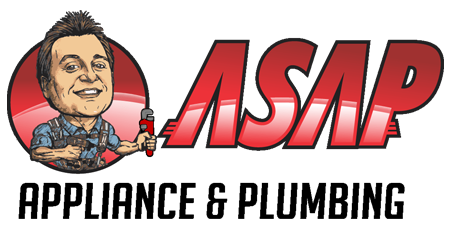When your refrigerator won’t stay cold, you need to address the problem immediately to keep your perishables from spoiling. Some problems only require simple maintenance while others may require a professional (and, in some cases, the problem may mean you need to buy a new fridge). To help you out, ASAP Plumbing and Appliance compiled a list to help you diagnose your potential problem, walk you through the repair, and explain when you should step back and let a professional handle it.
First, Check the Easy Stuff
- The refrigerator isn’t plugged in
This might sound silly but an alarming amount of people are quick to jump to conclusions without stopping to check if power is even running to their fridge. Don’t be that person.
- The thermostat has been turned down
Again, this seems like a no-brainer, but trust us. Locate your thermostat and check that it is set to an appropriate temperature. The FDA suggests the temperature should be set to 40 degrees or lower, while the freezer should be set at 0 degrees.
- The door doesn’t close properly
Double check the doors and gaskets. If the light in the fridge doesn’t turn on and off when you close the door, the door may not be functioning properly. Gaskets, the flexible strips around the door, are designed to seal the door shut. If the gasket is torn it could be leaking warm air into your fridge and is easy to replace yourself.
- The cold air isn’t circulating
This could be as simple as items in your fridge blocking the vents. This can obstruct the cold air from circulating through your fridge. Organizing or clearing out your fridge can be an easy fix to this problem!
The Condenser
If your fridge won’t cool but the light is working, it may be the condenser coils. The condenser coils are what release the heat from inside the refrigerator. If the coils are dirty, the refrigerator has to work harder to release that heat. The coils should be cleaned once a year with a vacuum or a long brush.
If the fridge just isn’t cool enough, there may be an issue with the condenser fan motor. The condenser fan motor, located under or behind the fridge, works by drawing air over the condenser coils to cool them. Without a function fan, your refrigerator could easily overheat and not cool properly. Check to see if there is debris on the fan blades, if so, gently wipe with a towel. If the blades are clean or don’t rotate at all, the fan’s motor needs to be replaced.

The Evaporator
There’s another set of coils, called the evaporator coils, in a panel behind the freezer. Refrigerant runs through these coils and turns into gas, making them cold. The evaporator fan draws cool air from these coils to circulate throughout the entire unit. If the evaporator fan motor is broken, cool air won’t circulate properly and you will need to have it replaced.
As mentioned above, the evaporator fan draws cool air from the coils and moves it throughout the entire unit. If the fan stops working, the coils may frost over. Remove the back panels and check for frost. If so, empty out the fridge and freezer, unplug the unit, and let the coils thaw for a day or two.
The Compressor
The compressor is the part of the fridge that compresses and pushes refrigerant vapor into the coils outside of the fridge. The pushing and pressure creates heat, forming hot gas that later cools and absorbs heat from the freezer and fridge. If your freezer fan is still running, but your fridge is not getting cold, your compressor could be bad.
The compressor is located behind the bottom of the fridge and is a black, tank-like part. Make sure it is unplugged before you get to work. Replacing the compressor start relay is cheaper than replacing the compressor itself. Simply buying a new relay start and testing it with your compressor may fix the problem.
To replace the compressor itself you’ll need to safely disconnect it from the suction line and compressor discharge line. You will also need to remove the electrical package and cut the high and low lines before loosening the bolts that hold the compressor in place. You can move the part closer to access and remove the ground wire. Your new compressor will need to be connected to your suction line, discharge line, and process line. The lines will require welds to secure them in place. Make sure to transfer the rubber grommets from your old compressor to the new and switch over the crossover line before evacuating the new system and dumping the new charge.
Air Inlet Damper
The air damper controls how much cold air is shared from the freezer to the fridge. If the air damper can’t open or close, it can impact the temperature of the fridge while the freezer works properly.
The air damper is located between the fresh food compartment and the freezer. To fix this problem, simply remove the air damper, remove any screws, and pull the cover off. The motor can be unscrewed and unplugged to move the motor out of the way. Remove the old air damper and install the new one.
From simple fixes like the thermostat to bigger issues like the compressor, your refrigerator may not be cooling for many reasons. From all of us here at ASAP Plumbing and Appliance, we wish you the best and hope you remember us for all of your refrigerator repair needs. Ready to call in the pros? Get in touch today.


